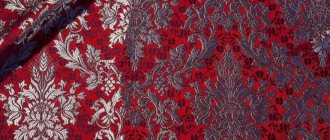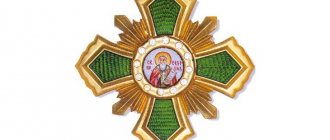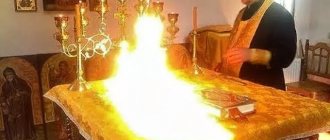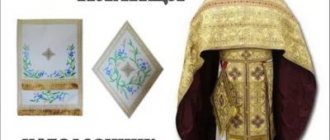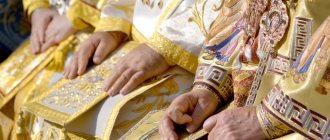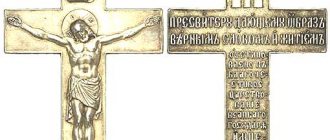Liturgical headdresses of Christian bishops and abbots
This article is about religious headdresses. For other uses, see Mithra (disambiguation).
"Bishop's hat" redirects here. For the plant, see Epimedium.
Miters in Western and Eastern style
A 19th century Catholic miter exhibited at the Museo dell'Opera del Duomo in Pisa, Italy
Miter Serbian Orthodox Bishop Georgiy Čokic
Miters in Western and Eastern styles worn by bishops
Catholic Archbishop José Palma wearing Western-style papal vestments, including a miter
Ukrainian Orthodox Bishop Alexander (Drabinko) wearing oriental style vestments, including a miter
The miter
(British English) (/ˈmaɪtər/; Greek: μίτρα, "headband" or "turban") or
miter
(American English; see differences in spelling), is a type of headdress now known as the traditional ceremonial headdress of bishops and some abbots in the traditional Christianity. Miters are worn in the Catholic Church, the Orthodox Church, as well as in the Anglican Communion, a few Lutheran churches, and by bishops and some other clergy in the Eastern Catholic Churches and Oriental Orthodox Churches. The Metropolitan Syrian Church of Malankara Mar Thoma also wears the miter during important ceremonies such as the Episcopal consecration.
Source
Etymology
μίτρα, mítra
(Ionic μίτρη,
mítrē
) is Greek, and means a piece of armor, usually a metal guard, worn around the waist and under the cuirass, as mentioned in the Homers Iliad.
Among later poets it was used to refer to the headband used by women for their hair; and a kind of formal Babylonian headdress, as mentioned by Herodotus ( Histories
1.195 and 7.90). This also applies to a type of headband such as: the head of a winner at games; headband and badge of rank at the Ptolemaic court; oriental headdress, perhaps a turban, etc. as a sign of delicacy, a diadem; priest's headdress Hercules; headdress of the Jewish high priest, etc.[1]
Byzantine Empire
The camel
(Greek: καμιλαύκιον,
kamilaukyon
), the headdress that both the miter and the Papal Tiara are from, was originally a cap used by officials of the Imperial Byzantine court. “The tiara [from which the miter is derived] was probably derived from the Phrygian cap or phrygium, a conical cap worn in the Greco-Roman world. In the 10th century, the tiara was depicted on papal coins."[2] Other sources claim that the tiara arose the other way around, from the miter. In the later Empire it developed into a closed type of Imperial Crown used by the Byzantine Emperors (see illustration Michael III, 842-867).
The miter worn by the bishop is first depicted in two miniatures from the early 11th century. The first written mention of him is found in the Bull of Pope Leo IX in 1049. By 1150 the use had spread to bishops throughout the West; by the 14th century, the tiara was decorated with three crowns.
Christian clergy
The Evolution of the Miter from The Catholic Encyclopedia
(1913)
Western Christianity
In its modern form in Western Christianity, the mitre is a high folding cap, consisting of two identical parts (front and back), rising with a visor and sewn on the sides. Two short legs always hang from the back.
In the Catholic Church, ecclesiastical law gives the right to use the miter and other pontifical insignia (staff, pectoral cross and ring) to (1) bishops, (2) abbots (3) cardinals and those who are canonically equivalent to diocesan bishops who have not received episcopal consecration. The chief cleric presents the miter and other papal insignia to the newly consecrated bishop during the Rite of Episcopal Ordination and to the new abbot during the Rite of Blessing of the Abbot. In the case of a person who is canonically equated with a diocesan bishop but does not receive episcopal consecration, this presentation usually occurs during a public installation according to the customs of his jurisdiction. Catholic Church Law also permits former Anglican bishops admitted into full communion and subsequently ordained as a priest of the Catholic Church to obtain permission to use the papal insignia as a sign of recognition of their previous ministry (they may also be admitted to national or ecclesiastical ministry). regional episcopal conference with status equivalent to that of retired Catholic bishops), but former Anglican bishops have not generally sought permission to use papal insignia under this provision.
Roman Catholic clergy wear three types of mitres for different occasions:
- The simplex
("simple", referring to the materials used) is made of white linen or silk without embellishment, and its white overlays are traditionally finished with red fringe. It is especially often worn at funerals, during Lenten times, on Good Friday and by concelebrant bishops on Mass. Cardinals, in the presence of the Pope, wear a miter made of white linen damask. - In auriphrygiata
of plain gold cloth or white silk with gold, silver or colored embroidery; nowadays it is usually worn by bishops when presiding over the celebration of the sacraments. - The Pretiosa
("precious") is decorated with precious stones and gold and is worn at the main mass on the most solemn Sundays (except Lent) and holidays. Today, this type of miter is rarely decorated with precious stones, and their designs have become more varied, simple and original, often simply in the liturgical color of the day.
The proper color of the miter is always white, although in liturgical use white also includes vestments of gold and silver cloth. Embroidered ribbons and other designs decorating the miter and paws can and often are of other colors. Although colored miters are sometimes sold and worn today, this is likely due to the maker or owner being unaware of the liturgical tradition.[ doubtful - debate
]
In all cases, the altar may wear a shawl veil, called a vimpa, over the shoulders while holding the bishop's miter.
With his inauguration as pope, Benedict XVI broke with tradition and replaced the papal tiara with even his papal coat of arms with the papal miter (containing still three levels of "crowns" representing the powers of the papacy in a simplified form) and pallium. Until Benedict XVI, the coat of arms of each pope always contained an image of the papal tiara and the crossed keys of St. Peter, although the tiara fell into disuse, especially under the popes. John Paul I and John Paul II. Pope Paul VI was the last pope to date to begin his papal reign with a formal coronation in June 1963. However, as a sign of the perceived need for greater simplification of papal rites, as well as the changing nature of the papacy itself, he abandoned the use of his tiara in a dramatic ceremony in St. Peter's Basilica during the second session of Vatican II in November 1963. However, his 1975 Apostolic Constitution made it clear that the tiara was not abolished: in the constitution he provided that his successor would receive a coronation. Pope John Paul I, however, refused to follow Paul VI's constitution and opted for a simpler papal inauguration, a precedent that was followed by his three successors. Pope John Paul II's Apostolic Constitution in 1996 left several options open, not specifying what type of ceremony should be used other than the one to be held to inaugurate a new pontificate.
Pope Paul VI donated his tiara (a gift from his former diocese of Milan) to help fight global poverty. Then, Francis Cardinal Spellman of New York received the tiara and took it with him on a tour of the United States to raise funds for the poor. It is permanently kept in the crypt of the church at the Basilica of the National Shrine of the Immaculate Conception in Washington, DC.
into the Church of England, the miter fell into disuse after the Reformation, but was restored in the late 19th and early 20th centuries. resulting in the Oxford Movement, and is now worn by most bishops of the Anglican Communion on at least some occasions. In the Episcopal Church of the United States, the first Presiding Bishop, Samuel Seabury, wore the miter as early as 1786. The miter is also worn by bishops of a number of Lutheran churches, such as the Evangelical Lutheran Church of Latvia and the Church of Sweden.[3]
In a church heraldry, it was placed above the shield of all persons who had the right to wear a miter, including abbots. It replaced the helmet of the military weapon, but also appeared as a crest placed on top of the helmet, as was common in German heraldry.[4] In Anglican churches, the miter is still placed above the bishops' coat of arms instead of the clerical hat. In the Roman Catholic Church, the use of the miter above the shield on the personal coat of arms of the clergy was banned in 1969.[5] and is now found only on some corporate coats of arms, such as those of dioceses. Previously, the miter was often included under the cap,[6] and even in the hands of a cardinal, the miter was not completely repositioned.[7] In heraldry, the miter is always depicted in gold, and the lappets (infulae) are of the same color. It has been argued that before the Reformation the distinction between the bishop's and the abbot's miter was made due to the lack of infulae in the hands of the abbot. In England and France it was customary to place the abbot's miter slightly in profile.[4]
- Miter simplex
traditional style: white damask with its white petals ending in a red border.
- Benedict XVI wearing Pretiosa
: elaborately embroidered miter.
- Papal coat of arms of Pope Benedict XVI. The papal tiara was replaced by the bishop's miter.
Eastern Christianity
Orthodox miter Capital Saint Chrysostom of Smyrna, martyred when the Turks captured the city in 1922.
An elaborately embroidered Eastern Orthodox miter, 1715. The most typical miter in the Eastern Orthodox and Byzantine Catholic churches is based on the closed Imperial crown of the late Byzantine Empire. Therefore, it is also ultimately based on the older καμιλαύκιον, although it separated from the secular headdress much later, after it had already undergone further development. The crown form was not used by bishops until the fall of Constantinople (1453).
The eastern miter is made in the form of an onion crown, completely closed, and the material is brocade, damask or gold fabric. It can also be embroidered, and is often richly decorated with jewelry. There are usually four icons attached to the miter (often Christ, the Virgin Mary, John the Baptist and the Cross), which the bishop may kiss before putting it on. Eastern miters are usually gold, but other liturgical colors may be used.
The miter is topped with a cross, made of metal and standing upright, or embroidered on fabric and lying flat on top. In Greek practice, the mitras of all bishops are crowned with a standing cross. The same is true in the Russian tradition. In miters given to priests, the cross will lie flat. Sometimes, instead of a flat cross, the miter may have a badge on the top.
Bishops of the Armenian Catholic Church in Jerusalem wear miters.
As an item of Imperial regalia, along with other items such as Sakkos (Imperial Dalmatic) and epigonation, the mitre came to signify the temporal power of bishops (especially the Patriarch of Constantinople) within the administration of Millet rum
(i.e. Christian community) Ottoman Empire. At certain ceremonial moments during the holiday, the miter is removed. Divine Liturgy and other services are usually removed and replaced by the protodeacon.
The use of the miter is the prerogative of bishops, but may be granted to bishops, protopresbyters and archimandrites. The priestly miter is not crowned with a cross and is awarded at the discretion of the synod of bishops.
Varieties of cassock
The Russian cassock is fastened end-to-end, without a zappa
ha, it has a fitted style. The sleeves are narrow at the shoulders and very wide at the bottom. The collar is fastened with a button. This style suits the harsh climate of our country: it allows you to save heat. At some official church events, the clergy of the Russian Orthodox Church is obliged to appear exclusively in robes of Russian cut.
There are two variations of the Russian cassock: the Kiev one - fitted only on the sides, and the Moscow one - fitted on all sides.
The Greek cassock came to Rus' in the 17th century, when the Great Moscow Council of 1666-1667 allowed the clergy to wear it. This cassock is much wider than the Russian one, is not fitted, fastens only at the collar and chest, and has a stand-up collar. Essentially, this is a transformation of an oriental robe. The sleeves of the Greek cassock are wide along the entire length. This meets the requirements of the hot southern climate, where this type of clothing was formed - Greek robes
made from natural silk. Russian priests gladly wear such robes in the summer, and many clergy prefer them at any time of the year, valuing freedom of movement. In Greece, priests wear black cassocks and cassocks, and the Russian tradition of colored clergy clothing causes them some surprise. Cassocks with satin silk cuffs on the sleeves are common. These lapels can also be colored - for example, purple.
A winter cassock can be insulated with batting or padding polyester and used as a coat. The collar of the winter cassock is turn-down, often made of fur or velvet. However, many priests, even those who constantly wear a cassock, prefer a regular coat or jacket in black. Instead of a skufia, they often wear an ordinary cap or hat.
Helpful advice. Features of sewing cassocks and cassocks
Some seamstresses make the mistake of not taking into account the difference between male and female figures, and the waist of the Russian cassock they sew ends up in the armpit area. Of course, this is wrong: the cassock is not a woman’s dress, and its waist should be in its place. They often sell cassocks and cassocks with unhemmed bottoms - meaning that everyone will tailor them to their height. But if necessary, you can shorten the hemmed vestment. Still, it’s more pleasant to buy clothes that you can wear right away.
Skufja is a black cap that covers the forehead. May have Russian
(more common) or
Greek style
.
In pre-Nikonov times, the shape of the skufia was different from the modern one and resembled a dome. Modern skufya is sewn in such a way that 4 folds
, forming a cross visible from above. The clergy's benches are made of velvety material.
Military uniform
Russian grenadier miter.
During the 18th century (and in some cases the 19th century), soldiers called grenadiers in various northern European armies wore a miter (commonly called a "miter") similar in outline to those worn by Western bishops. First adopted in the 1680s, this cap was worn in place of a regular wide-brimmed hat to prevent the headdress from being knocked off when a soldier threw a grenade.[8] The hand grenade in its primitive form became obsolete by the mid-18th century.[8] but grenadiers continued to be the elite troops in most European armies, usually retaining the miter as a distinction.
In military terms, this headdress had different styles. The Prussian style had a tapered brass or white metal front with a cloth back with a lace braid;[9] The Russian style was originally a tall brass plate over a leather cap with a visor at the rear, although the German model was subsequently adopted. The British style—commonly referred to simply as the "grenadier cap" instead of the miter—had a high cloth front with elaborate regimental embroidery in front of a sloping red back lined in white.[10] Some German and Russian riflemen of the regiment also wore a miter with a smaller brass plate.
By the end of the 18th century, due to changes in military fashion, the miter had largely given way to the miter. the bearskin was either replaced by the standard infantry cocked hat or two-horned hat. The British Army made this change in 1765, and the Prussian Army in 1790. However, all Russian grenadiers continued to wear miters until 1805, even when on active service.[11]
The miter in its classic 18th-century metal-fronted form survives as a piece of ceremonial dress in Prussia. Life Grenadier No. 1
and
the 1st Guards Regiment of the Zu Fuss
Regiment, plus the Russian Pavlovsk Regiment, before the First World War.
Varieties of clergy clothing
A cassock is a split garment that reaches to the edge of the boots, with long narrow sleeves and a closed collar. Most often it is black. In summer, in an informal setting, some priests wear light-colored cassocks: gray, cream, white, beige. Summer cassocks are most often sewn from cotton and linen
in a ratio of 80 to 20, 50 to 50 or
from pure flax
.
, wool and synthetics
are quoted .
The cassock and cassock have Russian and Greek versions.
Russian cassock
fastens end-to-end, odorless. Fitted to the figure.
On the chest of a Greek cassock
pockets are arranged. It is not fitted and has a stand-up collar.
Bulgarian cassock
is something of a cross between Russian and Greek: it has a “Greek” stand-up collar and “butted” floors, like a Russian cassock.
A cassock is a long robe, split in front, which is worn over a cassock; in contrast, it has wide sleeves that fit the palm. The word “cassock” originally meant “poor, worn out clothes.”
Other uses
Chess bishop in the standard Staunton pattern.
Notice the difference. The bishop in the board game of chess is a stylized Western miter with Unicode codes U+2657 (white) and U+265D (black): ♗♝.
Crowns from the Austrian Empire and Imperial Russia incorporated a miter made of precious metal and precious stones into their design. The Austrian Imperial Crown was originally the personal crown of the Holy Roman Emperor Rudolf II and has the shape proper to the Holy Roman Emperor. At the Roman Rite of their Coronation, the Pope placed a miter on their heads before placing a crown on it. Their empress consort also received a miter and crown on their heads from the cardinal bishop at the same ceremony. The shape of the Russian Imperial Crown dates back to the time of Peter the Great's early attempts to Westernize Russia, and was likely inspired by the crowns worn by the Habsburg Holy Roman Emperors, as well as possibly by the Orthodox miter.
The abbess of some very ancient abbeys in the West also wore mitres, but in a very different form from that worn by male prelates.
The mitral valve of the human heart, which lies between the left atrium and the left ventricle, is so named because of its similar shape to the miter. Andreas Vesalius, the father of anatomy, noted the striking similarities between the two in an anatomical dissection in the sixteenth century.[12]
Bishop's robes
The bishop's robe is a type of monastic robe. In everyday life, the bishop wears an ordinary black robe
, and puts on a special one - the bishop's one - when going to divine services, as well as during religious processions. In the temple it is solemnly removed, and the ruler dresses in sakkos.
The mantle is a long and wide garment in the form of a sleeveless cloak. The bishop's robe is fastened in 2 places: at the collar and below, and its length is such that a train is formed.
The bishop's mantle is decorated with tablets - quadrangular plates. On the upper part of the mantle there are two tablets with images of seraphim or crosses, less often - icons, and on the lower part there are two more, with the initials of the bishop. The tablets are reminiscent of those tablets with the Commandments
which were given to Moses on Mount Sinai. They indicate that the source of the bishop’s power in the Church is God, and in his activities the bishop is obliged to be guided by His Law.
Also on the bishop's mantle, evenly distributed along its length, are sewn 3 rows of horizontal ribbons of white and red colors - “sources” (“streams”). They remind us of the teaching of the Church - the Old and New Testaments, which the bishop is called to preach.
From the history of the bishop's mantle
A long, wide cloak - palium - was an attribute of the first Christians, not only clergy, but also laity. He pointed to humility, carelessness, purity of action and readiness to entrust one's life to God.
With the formation of monasticism
the mantle immediately became the attire of its wearers. The robes of desert hermits were simple and practical: they protected from the sun and could be wrapped in while sleeping.
From the 4th century A.D. bishops wore a robe woven from white wool. It was a symbol of a shepherd carrying a sheep on his shoulders, that is, it indicated the bishop’s duty to take care of the salvation of his flock. Since the 8th century, the white mantle has been a sign of the rank of metropolitan.
Symbolism of the bishop's robe
Mantle
- free, fluttering in the wind - symbolizes the wings of an angel, speaks of spiritual heights, prayerful flight. It marks the fullness of Divine grace, which the Lord bestows on those whom He places at the height of hierarchal service.
Here is how St. Simeon of Thessalonica wrote about the monastic mantle: “ The mantle...expresses the all-covering power of God, as well as the severity, reverence and humility of monastic life, and that the monk has neither hands nor other members that live or are free for worldly activities
».
The same saint reported about the bishop’s mantle: “ Tablets or tablets are sewn into the image of ancient and new grace. That is why they are relied upon above the sources: they also mean that the teacher must borrow teachings from the two Testaments
" “His (the bishop’s) mantle means the providing, containing and covering grace of God, and embraces and binds the whole body. Sources show that the teaching always flows from two Testaments, Old and New, which are signified by tablets or tablets.”
Notes
- first appears
- Britannica 2004, tiara
- Encyclopedia Britannica https://www.britannica.com/EBchecked/topic/386220/mitre
- ^ a b
"Church heraldry".
Catholic Encyclopedia
. 1913. - “Instruction”, 1969, No. 28.
- Lartigue, Dictionary
. - von Wohlbort, Heraldry of the World
, p.171, shows the Cardinal's coat of arms.
Francis Spellman with miter in 1967, just two years before 1969. Instructions
. - ^ a b
WY Carman, p. 68 "Dictionary of Military Uniforms", ISBN 0-684-15130-8 - Philip Haythornthwaite, page 13 "The Army of Frederick the Great, Volume 2 Infantry", ISBN 1855321602
- Stuart Reid, page 24 "King George's Army 1740-93, vol. 1 Infantry", ISBN 1 85532 515 2
- Philip Haythornthwaite, page 18 "The Russian Army in the Napoleonic Wars (1): Infantry, 1799-1814" ISBN 0-85045-737-8
- Charles Davis O'Malley, Andreas Vesalius of Brussels, 1514-1564 (Berkeley: University of California Press, 1964).

